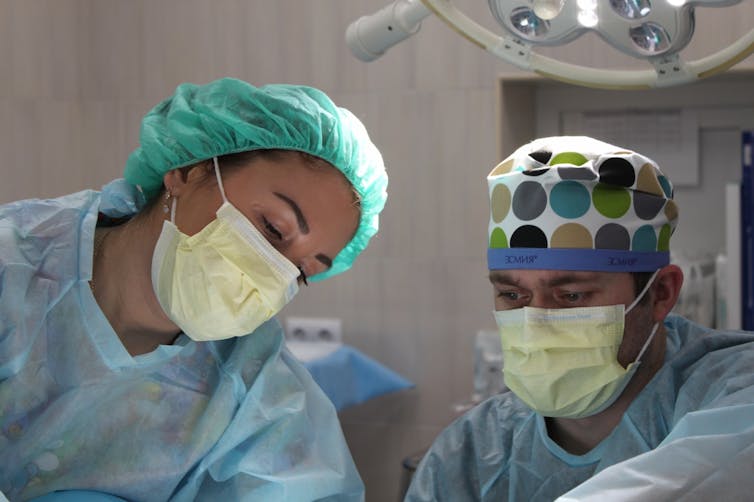Source: The Conversation (Au and NZ) – By Anthony Scott, Professor of Health Economics, The University of Melbourne

Sonny Sixteen/Pexels, CC BY-SA
Almost all GPs and most non-GP specialist doctors (such as cardiologists, gynaecologists and dermatologists) run private businesses to provide medical care in Australia. Business decisions can influence the costs of medical care, the care patients receive, and access to medical care in different geographic areas.
But until now, we’ve had no national data on the costs or profitability of running a private medical practice.
Our ANZ-Melbourne Institute Health Sector Report, out today, uses data from the Australian Bureau of Statistics on all medical businesses in Australia.
We examined trends in growth, costs and profitability, and how the financial health of doctors’ businesses has been affected during the COVID pandemic.
Among our findings, we show how medical businesses, in particular for non-GP specialists, remain very profitable compared to other businesses, including law, accountancy and finance.
Read more:
How much?! Seeing private specialists often costs more than you bargained for
Why should we care about medical businesses?
Many people seeking health care do not think about the costs involved, or the profitability of, running a private medical practice.
But the sudden closure of GP practices for financial reasons reduces access to health care for communities. For others, a focus on seeking profits means out-of-pocket costs can rise.
There are also more widespread reports of reduced access to bulk billing (where there are no out-of-pocket costs).
So how doctors run their private businesses is very much in the public interest.
Read more:
Health worker burnout and ‘compassion fatigue’ put patients at risk. How can we help them help us?
The growth of private practice
It was not too long ago that GPs and non-GP specialists worked largely on their own. But the benefits of working with others has led to a growth in private group medical practice.
GPs were the first doctors to do this. Now almost 90% of GPs report working in a group practice. But other specialists are rapidly catching up, where almost 70% now work in a private group practice.
The total number of doctors in a solo private practice has fallen by 0.5% between 2013 and 2020, while the number in group private practices has increased by 28.9%.

Cedric Fauntleroy/Pexels, CC BY-SA
Group practices can be good in keeping costs down by sharing the costs of premises, administration, nurses, and medical equipment. Working together can improve the quality of care and access to health care, as patients can easily see another GP in the practice if their preferred one is too busy. In a group practice, doctors can also more easily share knowledge.
But if businesses get too big, this could mean less choice for patients looking for a local doctor, and less competition. This could further increase out-of-pocket costs as there is less competitive pressure to keep fees low.
While more non-GP specialists are working in group private practice, they are also on average spending less time there. In 2020 they spent about three hours per week less in private practice compared to 2013.
Rising profits and costs
We show profits rose by an average of 2.4% a year for GP businesses and 5.3% a year for non-GP specialists businesses between 2005-6 and 2020-21.
Costs for GPs rose by an average 2.7% a year over the same time period. Turnover from total fees charged grew by 2.9%.
For non-GP specialists costs rose by an average 2% a year over the same time period, while turnover grew by 3.5%.
Overall the growth in costs for GP businesses was higher than for other specialists, and the growth in turnover was lower. This gap between costs and turnover has grown over time.
Non-GP specialists’ businesses made 50% more profit than GP businesses in 2020-21 ($216,468 and $144,485), compared to 14% more in 2005-6 ($120,452 and $105,924).
Read more:
We need more than a website to stop Australians paying exorbitant out-of-pocket health costs
Impact of COVID
Medicare coverage of telehealth meant GPs avoided losing income from the fall in face-to-face visits because of COVID. So revenue from fees continued to increase, though at a lower rate than before 2020.
Medical practices could also claim JobKeeper payments to maintain employment of practice staff. This financial support meant the number of GP and non-GP specialist businesses winding up or going bust actually fell during 2019-20. In fact, the total number of medical businesses continued to grow throughout the pandemic.
Profits initially fell during COVID by 1.9% for GPs and by 4.5% for non-GP specialists between 2018-19 and 2019-20.
But profits bounced back the following year because of the pent-up demand during the pandemic. People who were avoiding health care because of COVID or who had their elective surgeries cancelled, came back and still needed care.

Павел Сорокин/Pexels, CC BY-SA
This was especially the case for non-GP specialists, where profits grew by 10.8% between 2019-20 and 2020-21 compared to 2.2% for GPs.
However, medical businesses, especially GPs, experienced sudden increases in costs as they adapted to COVID settings. For GP businesses, costs increased by over 8% during the pandemic (4.1% between 2018-19 and 2019-20, and by 4% between 2019-20 and 2020-21.
It is expected demand will remain high for private medical care provided by GPs and non-GP specialists as people who delayed care and treatment during the pandemic return to seek care.
In fact, medical businesses, especially non-GP specialists, remain very profitable compared to other businesses such as law, accountancy, finance, construction and agriculture. In 2021, the median gross profit per business (turnover minus costs before tax) was $216,468 for non-GP specialists, $120,452 for GPs, and $124,431 for legal businesses.
Implications for patients
Achieving good access to high-quality medical care requires medical businesses to be located in areas of need and where out-of-pocket costs are kept to a minimum for low-income populations.
The growth in private group medical practice can mean medical businesses are run more efficiently, with continuing cost pressures leading to the formation of larger medical groups, especially for non-GP specialists.
In most cases maintaining profitability of private medical businesses is necessary to ensure their survival and maintain access to medical care, as long as out-of-pocket costs don’t increase at the same time.
![]()
Anthony Scott receives funding from the Australia and New Zealand Banking Group for the annual report series ‘ANZ-Melbourne Institute Health Sector Reports’. Professor Scott conducts the data analysis and writes the report.
– ref. Some GPs just keep their heads above water. Other doctors’ businesses are more profitable than law firms – https://theconversation.com/some-gps-just-keep-their-heads-above-water-other-doctors-businesses-are-more-profitable-than-law-firms-192163








